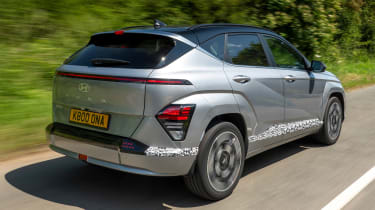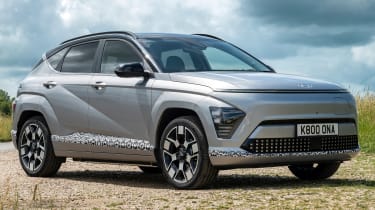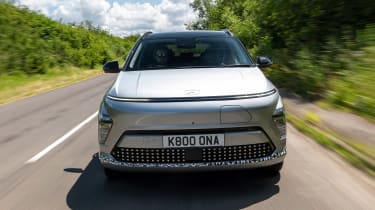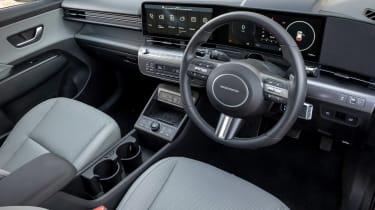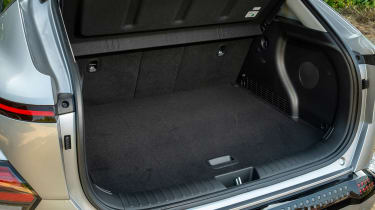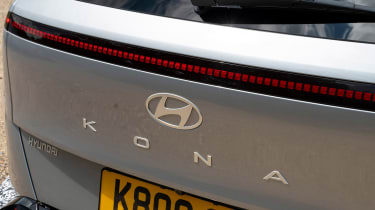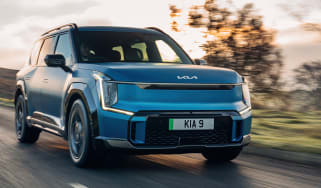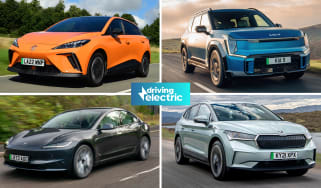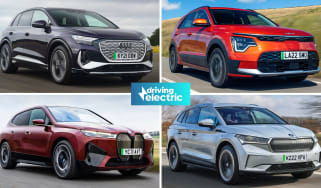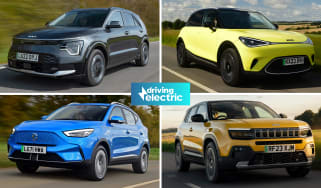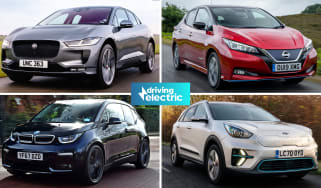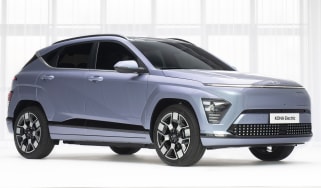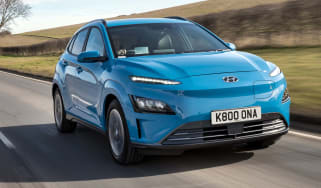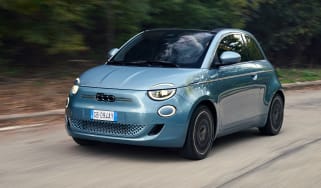Hyundai Kona Electric review
As futuristic as it is family friendly, the second-generation Hyundai Kona moves the game on from its predecessor in almost every respect
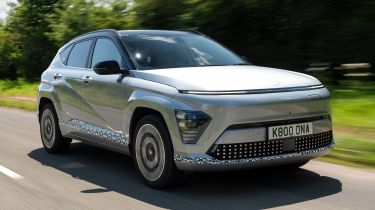
Pros
- Strong electric range
- Ergonomic interior
- Spacious
Cons
- Fussy styling
- Some EVs more fun to drive
- Top models aren't cheap
| Car type | Range | Wallbox charge time | Rapid charge time |
|---|---|---|---|
| Electric | 234-305 miles | 9hrs 15mins (0-100%, 7.4kW) | 43mins (10-80%, 102kW) |
Hyundai Kona Electric verdict
The second-generation Hyundai Kona has a lot to live up to – especially given our readers ranked its predecessor the best electric car to own in 2023. Thankfully, once your eyes can get past the optical illusion that is the exterior design, it becomes clear that the new Kona is, in fact, one of the most well-rounded electric family cars you can buy.
The zero-emissions Hyundai Kona has grown slightly for this latest model, and with this increase in size comes a plusher, better-equipped interior and a more sophisticated driving experience. A range of over 300 miles means the Kona Electric beats out many of its rivals, while a five-year warranty should make ownership a breeze. It may be rather expensive, but company car drivers and those who can find a competitive finance deal will not be disappointed.
Details, specs and alternatives
If a small electric SUV like the Vauxhall Mokka Electric doesn’t offer enough space for your family and a Tesla Model Y is too big and flashy, the Hyundai Kona slots neatly in between the two. Now in its second generation, the electric Kona is a rival for other small-ish electric family cars like the Renault Megane E-Tech, Volkswagen ID.3 and Smart #1.
While the first iteration of the Hyundai Kona didn’t rock the boat in terms of design, this new model channels its inner X-Man with Cyclops-like LED running lights at the front and rear. The wheelbase (the distance between the front and rear wheels) is now 60mm longer, while this latest model shares its platform with the new Kia Niro EV.
Unlike its Kia sibling which is only available with one powertrain setup, Kona Electric buyers have two options at launch. Base cars get a 48kWh battery alongside a 154bhp electric motor which, according to Hyundai, allows for a range of up to 234 miles – roughly 15 miles more than a base Citroen e-C4.
More impressive is the top-spec 65kWh model with its punchier 215bhp electric motor. The headline figure is a WLTP range of up to 305 miles, which is a chunk more than what you’d get in the equivalent Niro EV, as well as the likes of the smaller and similarly-priced Peugeot e-2008.
In terms of the Hyundai’s trim levels, there are four to choose from: Advance, N Line, N Line S and Ultimate, with the Advance being the only option if you choose the smaller battery. That’s no issue, as standard equipment is strong; all cars get full-LED headlights, dual-zone climate control, all-round parking sensors, a reversing camera and a dual-screen infotainment system setup with sat nav, Apple CarPlay and Android Auto connectivity. A ‘Comfort Pack’ with heated front and rear seats, plus a heated steering wheel, can be added for £600.
N Line adds a racier bodykit, as well as wireless phone charging and ambient lighting, while N Line S cars take things a step further with leather and Alcantara upholstery, ventilated front seats, a BOSE sound system and blind-spot monitoring. If you’d rather go without the flashy styling, top-of-the-range Ultimate models get a more subdued look, a panoramic sunroof and posh-feeling leatherette upholstery.
Range, battery size & charging
| Model | Range | Wallbox charge time | Rapid charge time |
|---|---|---|---|
| 48kWh | 234 miles | 6hrs 30mins (0-100%, 7.4kW) | 41mins (10-80%, 102kW) |
| 65kWh | 305 miles | 9hrs 15mins (0-100%, 7.4kW) |
43mins (10-80%, 102kW) |
As mentioned, the Hyundai Kona Electric is available with two battery sizes: 48kWh and 65kWh. The former offers a maximum range of 234 miles and is best-suited to drivers that spend most of their time driving around town.

Like with the first-generation Hyundai Kona Electric, we once again predict most buyers will opt for the larger 65kWh battery. This provides a range of up to 305 miles, which is rather more than what’s possible in a Renault Megane E-Tech or a Volkswagen ID.3 Pro.
Hyundai says the new Kona Electric can charge at speeds of up to 102kW, meaning a 10-80% top-up at a public ultra-rapid charger will take just under 45 minutes. Given the sizes of the Kona’s battery packs, we expect a full charge to take anything between six-and-a-half and nine hours, when connected to a standard 7.4kW home wallbox.
Running costs & insurance
Entry-level Hyundai Kona models start from a reasonable £35,000, but top-of-the-line Ultimate cars top the £43,000 mark. Thankfully, company car drivers will be able to largely ignore this and instead focus on the electric Hyundai’s ultra-low 2% Benefit-in-Kind tax rating; an Advance model with the larger battery is liable for as little as £154 per year in company car tax. Like other electric cars, the Hyundai Kona Electric also benefits from a road tax (VED) exemption until 2025, and can enter London’s Congestion Charge and Low Emissions (ULEZ) zones for free as well.
Performance, motor & drive
| Model | 0-62mph | Top speed | Driven wheels | Power |
|---|---|---|---|---|
| 48kWh | 8.8s | 101mph | Front | 154bhp |
| 65kWh | 7.8s | 107mph | Front |
215bhp |
Straight off the bat, the new Hyundai Kona Electric marks a noticeable improvement over the old model in terms of comfort and refinement. Only the busiest of road surfaces manage to unsettle it, with the Kona’s otherwise well-damped ride made even more cosseting thanks to a noticeable lack of wind and road noise.
It’s true that the majority of models in this segment prioritise comfort over driving dynamics, and the Kona Electric is no different; the steering is nicely weighted, but lacks much in the way of feel. Don’t go attacking any twisty B-roads, as turning into a corner at high speed results in the Kona Electric losing some of its otherwise impressive composure.
Around town, even the base Kona with its 154bhp motor offers enough zest to dart between traffic lights. All models provide the instant punch we’ve come to expect from electric cars, but the range-topping 215bhp is even more impressive. It’s no Tesla Model 3, but the 65kWh Kona will be potent enough for most owners; while the base model runs out of puff at the top end, the top-spec Kona is perfectly capable of swift motorway overtakes. If you’re looking for an EV that’s exciting to drive, you’re better-off looking at either the Cupra Born or MG4 XPower, though.
Interior, dashboard & infotainment
The pursuit of minimalism has become somewhat of a scourge on the interiors of many new cars, with manufacturers ignoring ergonomics and incorporating almost all of a car’s functions into a fiddly infotainment screen.
Not so with the latest Hyundai Kona Electric – the South Korean brand has managed to fill the interior with easy-to-operate buttons and switches, without making it feel overwhelming and dated. Quality is strong throughout, with lots of classy metal-effect trim, solid-feeling plastics and luxurious leatherette upholstery on top models.
Of course, that’s not saying the Hyundai Kona Electric is completely screen-less; the standard-fit dual 12.3-inch screens are not only sharp to look at, but respond well to your inputs. These run a new version of Hyundai’s Bluelink software, featuring configurable widgets and built-in sat nav, plus Apple CarPlay and Android Auto connectivity.
Boot space, seating & practicality
| Length | Width | Height | Boot space (seats up/down) |
|---|---|---|---|
| 4,355mm | 1,825mm | 1,575mm | 466/1,300 litres |
An increase in size suits the Hyundai Kona well as it now offers a significant amount more space than smaller, similarly-priced models like the Jeep Avenger and Vauxhall Mokka Electric. There’s plenty of room to seat four adults comfortably, and while it may be a bit of a squeeze if you want to sit three people abreast in the back, the flat floor at least means there’s space for everyone’s feet.
Unlike some electric SUVs like the Volvo XC40 Recharge, the Hyundai Kona Electric doesn’t have a proper ‘frunk’ under the bonnet – there is a tiny storage bin, though, enough for little more than a small shopping bag. What it does have, however, is a roomy 466-litre boot, which is marginally less than its sister car, the Kia Niro EV, but still up there with the best in class.
One thing worth noting is that all Hyundai Kona Electric models come as standard with Vehicle-to-Load (V2L) charging capability; there’s a three-pin plug on the back of the centre console, allowing you to power anything from a laptop to a microwave – should you ever need it.
Reliability & safety rating
Few cars have quite had the same effect on their owners as the Hyundai Kona, with the outgoing model being ranked the best electric car to own in 2023. The latest model sits on the same platform as the new Kia Niro EV, which still managed to make it into our top-15 ranking – we’ll be keeping an eager eye out to see how the new Kona fares in next year’s survey.
Regardless, electric cars should be relatively painless to own given they incorporate very few moving parts to go wrong – Hyundai’s strong five-year warranty should encourage peace of mind in this regard. With an extensive suite of safety systems, the Kona Electric should be pretty safe, too; it’s yet to undergo crash testing by Euro NCAP, but we expect the Hyundai to match the Niro EV’s full five-star safety rating.
